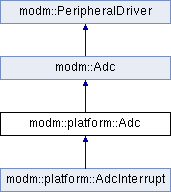|
modm API documentation
|
|
modm API documentation
|
#include <modm/platform/adc/adc.hpp>

Public Typedefs | |
| typedef uint8_t | Channel |
Public Types | |
| enum | Reference : uint8_t { InternalRef = 0, InternalVddNoCapacitor = 0x40, Internal1V5NoCapacitor = 0x80, Internal1V6NoCapacitor = 0xc0 } |
| enum | InterruptFlag : uint8_t { All = (1<<ADIF) } |
Public Member Functions | |
| MODM_FLAGS8 (InterruptFlag) | |
Static Public Member Functions | |
| template<class... Signals> | |
| static void | connect () |
| template<class SystemClock , frequency_t frequency = kHz(100), percent_t tolerance = pct(10)> | |
| static void | initialize () |
| static void | disable () |
| static void | startConversion () |
| static bool | isConversionFinished () |
| static uint16_t | getValue () |
| static uint16_t | readChannel (Channel channel) |
| static bool | setChannel (Channel channel) |
| static uint8_t | getChannel () |
| static void | enableFreeRunningMode () |
| static void | diableFreeRunningMode () |
| static void | setLeftAdjustResult () |
| static void | setRightAdjustResult () |
| static void | setReference (Reference reference) |
| static bool | getInterruptFlag () |
| static InterruptFlag_t | getInterruptFlags () |
| static void | acknowledgeInterruptFlag () |
| Clears the interrupt flag. | |
| static void | acknowledgeInterruptFlags (const InterruptFlag_t flags) |
Clears the interrupt flag if flags is set to InterruptFlag::All | |
| static void | enableInterrupt () |
| Enables the ADC Conversion Complete Interrupt. | |
| static void | disableInterrupt () |
| Disables the ADC Conversion Complete Interrupt. | |
| static void | enableAutoTrigger () |
| static void | disableAutoTrigger () |
| Disable auto triggering of the ADC. | |
| static void | setAutoTriggerSource (uint8_t source) |
| static bool | isAvddOk () |
| static bool | isReferenceVoltageOk () |
| static void | setAnalogChannelChange () |
| template<uint64_t available, uint64_t requested, percent_t tolerance> | |
| static void | assertBaudrateInTolerance () |
| template<double available, double requested, percent_t tolerance> | |
| static void | assertDurationInTolerance () |
| static void | configurePurpose () |
| configures a peripheral for a specific purpose | |
| static void | disableFreeRunningMode () |
| static void | getParameter () |
| returns a parameter | |
| static void | setParameter () |
| sets a parameter | |
Static Public Attributes | |
| static constexpr uint8_t | Resolution = 10 |
Generic Analog/Digital-Converter module
This class aims at providing a common interface to all the different register layouts of the ADC modules in most ATmegas. It takes into consideration restrictions and extensions in ADC functionality and provides the appropriate methods to configure them.
This class enables you to address and use a broader array of ATmegas with similar ADC functionality without changing a single line of code.
For best use of this class, check your device's datasheet for the supported functionality.
ADC clock frequency should be between 50 and 200 kHz for maximum resolution. If less than the full resolution of 10 bits are needed the frequency can be higher.
|
inheritedinlinestatic |
Since baudrates are usually generated by prescaling a system clock, only several distinct values can be generated. This method checks if the user requested baudrate is within error tolerance of the system achievable baudrate.
|
inheritedstatic |
|
inlinestatic |
Enable auto triggering of the ADC
The ADC will start a conversion on a positive edge of the selected trigger signal.
|
inlinestatic |
true if the flag is set, false otherwise
|
inlinestatic |
InterruptFlag::All if the flag is set, 0 otherwise
|
inlinestatic |
The analog functions of the ADC are powered from the AVDD domain. AVDD is supplied from an internal voltage regulator. Enabling the ADC will power-up the AVDD domain if not already requested by another functional group of the device. This method allows the user to monitor (poll) the status of the AVDD domain.
true indicates that AVDD has been powered-up.
|
inlinestatic |
The status of the internal generated reference voltage can be monitored through this bit. After enabling the ADC and setting the reference voltage, it will be available after a start-up delay.
true which indicates that the internal generated reference voltage is approaching final levels.
|
inlinestatic |
Read the value an analog channel
A normal conversion takes 13 ADC clock cycles. With a clock frequency of for example 200 kHz a conversion therefore needs 65 microseconds. This time increases with a lower frequency.
|
inlinestatic |
The user can force a reset of the analog blocks by setting this without requesting a different channel. The analog blocks of the ADC will be reset to handle possible new voltage ranges. Such a reset phase is especially important for the gain amplifier. It could be temporarily disabled by a large step of its input common voltage leading to erroneous A/D conversion results.
|
inlinestatic |
Selects which source will trigger an ADC conversion
A conversion will be triggered by the rising edge of the selected Interrupt Flag. Note that switching from a trigger source that is cleared to a trigger source that is set, will generate a positive edge on the trigger signal. Set to 0 to enable Free Running Mode.
|
inlinestatic |
voltage reference for the ADC
The internal voltage reference options may not be used if an external reference voltage is being applied to the AREF pin.